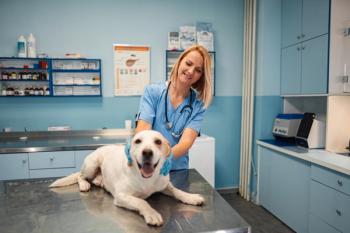
There's no ''I'' in ''Ouch!''
At a recent CVC session, pain expert Tasha McNerney explains the different roles team members play in recognizing and managing pain and why each role is important.
Photo: Shutterstock/Ksenia RakovaPain recognition and management is everyone's job, but not everyone has the same role, says Tasha McNerney, BS, CVT, CVPP, VTS (Anesthesia/Analgesia). Proper pain management takes a team, and it starts before the animal even enters the building.
Photo: Shutterstock/AdyaReceptionists: Front line investigators
“The receptionist is the front line for obtaining information from the client,” says McNerney. When clients call, it's the receptionist's job to start the pain management conversation and ask questions that will help reveal what type of pain the animal is experiencing.
McNerney offers several examples:
“How long has your pet been experiencing pain?”
“Does the pain appear to be localized to one area?”
“Is your pet licking or biting at a certain area of the body?”
“Has your pet stopped eating/grooming/jumping/running?”
“Does your pet take a long time to stand after sitting or sleeping?”
The receptionist's duties go beyond the phone, however. McNerney adds that they should be trained to take patients presenting to the clinic with signs of extreme pain (e.g., lateral, visible trauma, trouble breathing, howling in pain, etc.) to the treatment room immediately.
Photo: Shutterstock/absolutimagesTechnicians/Nurses: Cardinal communicators
“The meat and potatoes of pain management in the veterinary clinic usually comes from nurses,” says McNerney. Nurses are the ones watching the patients as they walk into the exam room and evaluating them post-surgery. They also spend a lot of time talking with owners.
When nurses bring patients into the exam room for a physical exam, McNerney says they should ask owners questions like:
“Has your pet's activity level decreased?”
“Is your pet reluctant to go upstairs or jump up on things?”
“Has your pet been reluctant to eat hard food?”
“Do you feel like your pet's current pain medication is working?”
“Are you supplementing with any other medications?”
If doing an intake prior to surgery or a dentistry procedure, McNerney advises nurses to talk to clients about what to expect. “Talk about the anticipated level of pain with the owner. Ask the owner how they feel about giving analgesic medications and talk about different modalities,” says McNerney. It's important to talk about options, as not all pets can take medication orally, and not all owners are comfortable bringing up that their pet falls into this category.
It's also important for nurses to tell owners about potential pain medication side effects as well as what they should do if observed. For example, opioids may make pets nauseous and whiny, and owners should be advised to call the office if such side effects occur.
Photo: Dora ZettDoctors: Multimodal management mappers
Doctors combine information from receptionists, owners, and nurses with what they learn from their own physical examinations to create a multimodal treatment plan. “The principle of multimodal therapy is to use analgesic drugs and physical therapy modalities that target several different steps of the pain pathway, allowing for more effective pain control with lower doses and fewer side effects,” McNerney says.
McNerney calls opioids and NSAIDs the cornerstones of pain management in surgery and dentistry patients. “Those are the two you always want to consider including in postoperative pain management,” she says. Other options include NMDA-receptor antagonists, tricyclic antidepressants and non-pharmacologic options such as acupuncture, laser therapy, physical therapy, pulsed magnetic field therapy and hydrotherapy.
Again, it's important to discuss medication expectations at this point. The perfect pain plan will fail if the client is physically unable to give the pet what the doctor prescribes.
Photo: Shutterstock/HysteriaKennel staff: Keen observers
Kennel staff play an important role in recognizing patients in pain too, McNerney says. Kennel staff may notice a pet is limping or is sensitive when a certain area is touched, or they may see that a patient is uncomfortable and unable to rest.
According to McNerney, “If the kennel staff notices signs of pain in boarding patients, they should alert the nurses or veterinarians so the owner can be notified and proper pain management plans can be enacted.”
Newsletter
From exam room tips to practice management insights, get trusted veterinary news delivered straight to your inbox—subscribe to dvm360.






